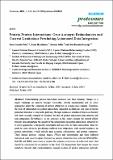Por favor, use este identificador para citar o enlazar a este item:
http://hdl.handle.net/10261/150285COMPARTIR / EXPORTAR:
 SHARE SHARE
 CORE
BASE CORE
BASE
|
|
| Visualizar otros formatos: MARC | Dublin Core | RDF | ORE | MODS | METS | DIDL | DATACITE | |

| Título: | Protein-Protein Interactions: Gene Acronym Redundancies and Current Limitations Precluding Automated Data Integration |
Autor: | Casado-Vela, Juan CSIC ORCID CVN; Matthiesen, Rune; Sellés, Susana; Naranjo, José Ramón CSIC ORCID | Director: | European Commission | Fecha de publicación: | 31-may-2013 | Editor: | Multidisciplinary Digital Publishing Institute | Citación: | Proteomes 1 (1): 3-24 (2013) | Resumen: | Understanding protein interaction networks and their dynamic changes is a major challenge in modern biology. Currently, several experimental and <i>in silico</i> approaches allow the screening of protein interactors in a large-scale manner. Therefore, the bulk of information on protein interactions deposited in databases and peer-reviewed published literature is constantly growing. Multiple databases interfaced from user-friendly web tools recently emerged to facilitate the task of protein interaction data retrieval and data integration. Nevertheless, as we evidence in this report, despite the current efforts towards data integration, the quality of the information on protein interactions retrieved by <i>in silico</i> approaches is frequently incomplete and may even list false interactions. Here we point to some obstacles precluding confident data integration, with special emphasis on protein interactions, which include gene acronym redundancies and protein synonyms. Three human proteins (choline kinase, PPIase and uromodulin) and three different web-based data search engines focused on protein interaction data retrieval (PSICQUIC, DASMI and BIPS) were used to explain the potential occurrence of undesired errors that should be considered by researchers in the field. We demonstrate that, despite the recent initiatives towards data standardization, manual curation of protein interaction networks based on literature searches are still required to remove potential false positives. A three-step workflow consisting of: (i) data retrieval from multiple databases, (ii) peer-reviewed literature searches, and (iii) data curation and integration, is proposed as the best strategy to gather updated information on protein interactions. Finally, this strategy was applied to compile <i>bona fide </i>information on human DREAM protein interactome, which constitutes liable training datasets that can be used to improve computational predictions. | Versión del editor: | https://doi.org/10.3390/proteomes1010003 | URI: | http://hdl.handle.net/10261/150285 | DOI: | 10.3390/proteomes1010003 | Identificadores: | doi: 10.3390/proteomes1010003 |
| Aparece en las colecciones: | (CNB) Artículos |
Ficheros en este ítem:
| Fichero | Descripción | Tamaño | Formato | |
|---|---|---|---|---|
| proteomes-01-00003-v2.pdf | 732,93 kB | Adobe PDF |  Visualizar/Abrir |
CORE Recommender
SCOPUSTM
Citations
1
checked on 29-abr-2024
Page view(s)
259
checked on 05-may-2024
Download(s)
194
checked on 05-may-2024
Google ScholarTM
Check
Altmetric
Altmetric
Este item está licenciado bajo una Licencia Creative Commons

